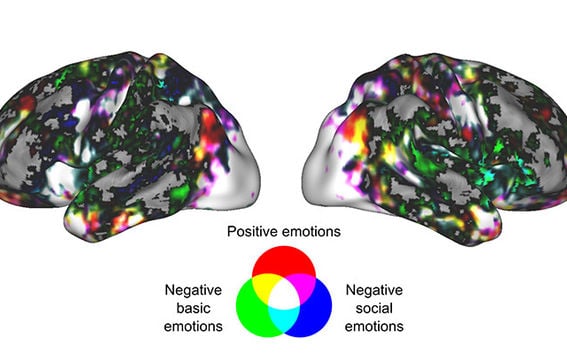Love and fear are visible across the brain instead of being restricted to any brain region

In the field of affective neuroscience, rivalling theories debate whether emotional states can be regarded as an activity of only certain brain regions. According to a new doctoral dissertation at Aalto University, an emotional state affects the operation of the entire brain instead of individual emotions being localised only in specific regions in the brain.
‘From the biological point of view, an emotion is a state of the entire brain at a given moment. For example, the brain may interpret certain action models, memories and bodily changes altogether as anger,’ explains Doctoral Candidate Heini Saarimäki.
Different emotional states of the participants were evoked with films, mental imagery or guided imagery based on narratives. After that, a classifier algorithm based on machine learning was trained to connect the specific emotions and the brain data related to them. The classifier algorithm was then tested by giving it new brain data and by measuring how successfully the algorithm recognised the correct emotion solely on the basis of the brain data. The method for measuring brain activity is based on measuring the changes in the blood oxygen content in the brain and it provides information on the activation of the brain with millimetre-accuracy.
The researchers were particularly interested in emotion-specific brain maps, that is, maps on the localisation of emotions in various areas across the entire brain. By analysing the activity of the entire brain, a machine learning algorithm may be able to determine the emotional state in question.
Saarimäki and her colleagues discovered that the brain maps of basic emotions such as anger, happiness, sadness, fear, surprise and disgust were to some extent similar across people. Basic emotions seem to be at least partially biologically determined, whereas social emotions – gratitude, contempt, pride and shame – are to a greater extent built on experience. In social emotions, the differences in brain activity between people are greater than in basic emotions.
From groups of similar emotions to the power of empathy
The classifier algorithm makes more mistakes with distinguishing emotions that have similar brain maps than with emotions whose brain maps have little in common. This information can be further compared to how people interpret certain emotions subjectively. Positive emotions, such as happiness, love, gratitude and pride, are more similar both as subjective experiences and at the level of brain activity. Negative emotions, such as fear, anger and sadness, on the other hand, have as a group a similar basis in brain activity. The brain activities during negative social emotions such as shame, guilt and contempt, in turn, resemble each other most but differ from the brain maps of basic negative emotions.
‘We also discovered that the accuracy of emotion classification seems to be related to individual differences in emotional processing, such as in the ability to feel empathy. We want to examine in more detail how individual differences, for example in empathy, are linked to the functioning of the emotional systems of the brain. A separate research project investigating this is about to begin,’ Saarimäki explains.
The results of the study benefit the treatment of mental health disorders or memory loss diseases, which both appear to be clearly connected to emotional disorders. A better understanding of the brain mechanisms of different emotions may be helpful in planning and targeting treatment correctly.
Heini Saarimäki will defend the dissertation "Decoding emotions from brain activity and connectivity patterns" on 16 February.
Further information:
Heini Saarimäki
Doctoral Candidate
Aalto University
[email protected]
tel. +358 50 370 7385
Mikko Sams
Professor
Aalto University
[email protected]
tel. +358 50 521 5739
- Published:
- Updated:
Read more news

Join us for the first Aalto Open Science Award Ceremony
All Aaltonians are welcome – no registration required!
Donor story - Yrjö Sotamaa: ‘Supporting the university is about building our own future’
Professor Emeritus is still an active design influencer both at home and internationally. He is now also a monthly donor to School of Arts, Design and Architecture.
Doctoral education pilot arouses wide interest among applicants and corporate partners
The doctoral education pilot has got off to a fast start.